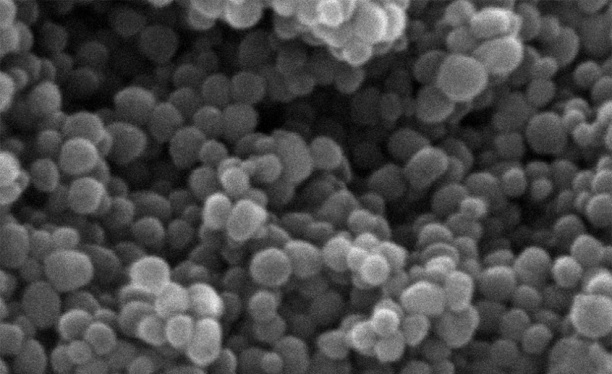Silicon Nanoparticles/Nanopowder and Applications of Silicon Nanopowders/Nanoparticle
What is Silicon?
Silicon is a chemical element with symbol Si and atomic number 14. It is a hard and brittle crystalline solid with a blue-grey metallic lustre. Silicon is relatively unreactive. Silicon is the eighth most common element in the universe by mass, but very rarely occurs as the pure element in the Earth's crust.
Elemental silicon also has a large impact on the modern world economy. Most free silicon is used in the steel refining, aluminum-casting, and fine chemical industries (often to make fumed silica).
Silicon Nanoparticles/Nanopowder and Their Applications

Silicon nanoparticles/nanopowder are used in many different areas. One of the most exciting usage area of silicon nanoparticles/nanopowder is lithium-ion batteries. In lithium-ion batteries Silicon nanoparticles/nanopowder provide extreme performance, as high as triple the energy storage potential of regular lithium-ion batteries. In solar energy cells silicon nanoparticles/nanopowder are used. Silicon nanoparticles/nanopowder are well known widely used as semiconductor material. Silicon nanoparticles/nanopowder are used in electronics industry, LEDs, nanocomposites and memory devices.
Technical Properties of Our Si (Silicon) Nanoparticles/Nanopowder, 97+%, 25-35 nm, Laser Synthesized Product
| True Density (g/cm3): | 2,3 |
| Bulk Density (g/cm3): | 0,1 |
| Shape: | spherical |
| Crystal Structure: | polycrystalline |
| Color: | light brown |
| AVERAGE PARTICLE SIZE (nm): | 25-35 |
| SPECIFIC SURFACE AREA (m2/g): | 95-140 |
You may order Si (Silicon) Nanoparticles/Nanopowder, 97+%, 25-35 nm, Laser Synthesized from the link given below:
Technical Properties of Our Si (Silicon) Nanoparticles/Nanopowder, 97+%, 35-55 nm, Laser Synthesized, Product
| True Density (g/cm3): | 2,3 |
| Bulk Density (g/cm3): | 0,1 |
| Shape: | spherical |
| Crystal Structure: | polycrystalline |
| Color: | light brown |
| AVERAGE PARTICLE SIZE (nm): | 35-55 |
| SPECIFIC SURFACE AREA (m2/g): | 75-95 |
You may order Si(Silicon) Nanoparticles/Nanopowder, 97+%, 35-55 nm, Laser Synthesized from the link given below:
Technical Properties of Our Si (Silicon) Nanoparticles/Nanopowder 97+%, <70 nm, Laser Synthesized Product
| True Density (g/cm3): | 2,3 |
| Bulk Density (g/cm3): | 0,05 |
| Shape: | spherical |
| Crystal Structure: | polycrystalline |
| Color: | light brown |
| AVERAGE PARTICLE SIZE (nm): | <70 |
| SPECIFIC SURFACE AREA (m2/g): | >50 |
You may order Si (Silicon) Nanoparticles/Nanopowder 97+%, <70 nm, Laser Synthesized from the link given below:
Technical Properties of Our Si (Silicon) Nanoparticles/Nanopowder, 97+%, 45-65 nm, Laser Synthesized Product
| True Density (g/cm3): | 2,3 |
| Bulk Density (g/cm3): | 0,045 |
| Shape: | spherical |
| Crystal Structure: | polycrystalline |
| Color: | light brown |
| AVERAGE PARTICLE SIZE (nm): | 45-65 |
| SPECIFIC SURFACE AREA (m2/g): | >50 |
You may order Si (Silicon) Nanoparticles/Nanopowder, 97+%, 45-65 nm, Laser Synthesized from the link given below:
Technical Properties of Our Si(Silicon) Nanoparticles/Nanopowder 99.5+%,90nm, Nanopowder/Nanoparticle & Nanowire Product
| True Density (g/cm3): | 2,3 |
| Bulk Density (g/cm3): | 0,08 |
| Shape: | nanoparticles/nanopowder and nanowires |
| Crystal Structure: | polycrystalline |
| Color: | brown |
| AVERAGE PARTICLE SIZE (nm): | 90 |
| SPECIFIC SURFACE AREA (m2/g): | 45-80 |
You may give an order for Si(Silicon) Nanoparticles/Nanopowder 99.5+%,90nm, Nanopowder/Nanoparticle & Nanowire from the link given below
Comments
Post a Comment